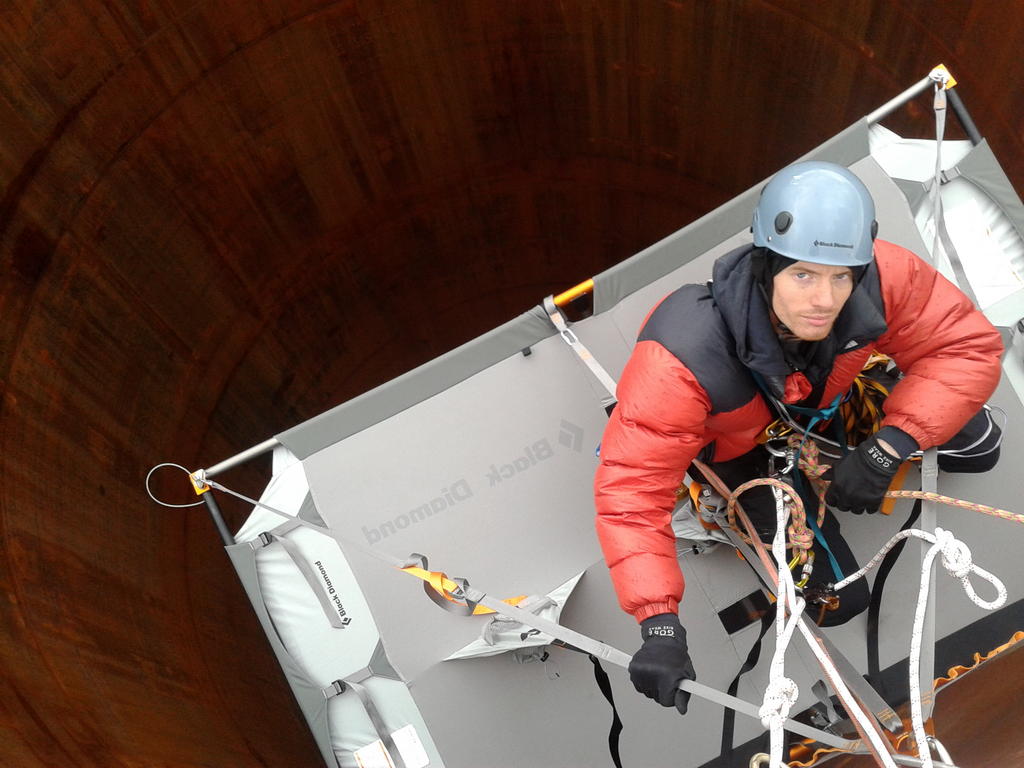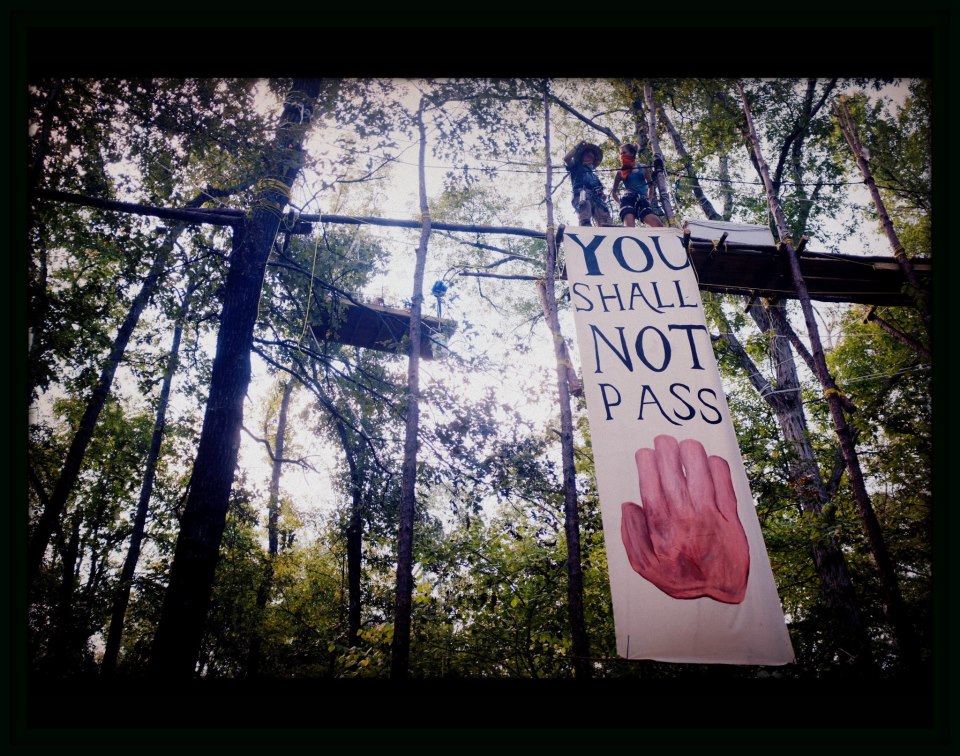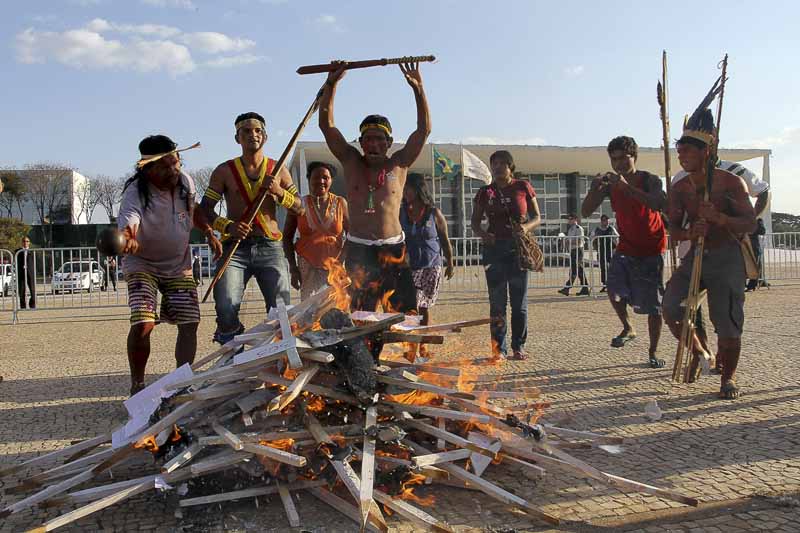
by Deep Green Resistance News Service | Oct 29, 2012 | Obstruction & Occupation
By Martin Wainwright / The Guardian
Around 20 climate change protesters have seriously disrupted operations at one of the UK’s new generation of gas-fired power stations at West Burton in Nottinghamshire.
Police have made five arrests but overnight eleven protesters from the campaign group No Dash for Gas successfully scaled the middle of the plant’s 91m (300ft) metal chimneys – the plant’s water cooling towers – and another six have occupied a second one which was not yet in use, securing themselves on ledges.
One of the group tweeted exuberantly with accompanying pictures: “Guess where we woke up this morning! Dawn sun shining on other chimney where friends are perched on the ledge.”
Speaking from the group’s makeshift but sophisticated camp slung on the central chimney shortly before 1pm, one of them said: “we are settling in nicely. At the moment some of us are setting up a solar panel and there’s a group fixing our portable loo. We’ve got a portable ledge lowered a short way down the flue with plenty of room for people to sleep on. EDF [the plant’s operator] have assured us that the chimney had been shut down but we’re still a but worried about gases being around. But the plan is to stay up here with some of us in the flue to stop the furnace starting again.”
Ben Healey of No Dash For Gas said that the middle of the plant’s three cooling towers had been working but had now shut down, with steam no longer pouring from its brim. He said: “There are nine activists up there and they have started abseiling down into the flue to prevent the furnaces being relit. That means we are in for the long haul.
“The six people on the other chimney, which is not yet fully built, have barricaded themselves in place and will be very difficult to dislodge.”
The protesters said they had spent a busy night climbing the chimney and hauling up their equipment and food supplies to last at least a week.
The plant’s owners and operators EDF confirmed that the middle tower had been closed down.
No Dash for Gas said that the action was aimed at stopping operations at the £600m power station that is one of a cluster of plants built around the site of the deserted medieval village of West Burton in the valley of the River Trent.
The group said: “West Burton power station is being targeted because it’s one of the first in a new generation of highly polluting gas plants planned for the UK. The coalition government recently announced that it intends to give the green light to as many as 20 new gas plants – a move that would crash Britain’s carbon targets, contribute to the climate crisis and push up bills.”
Nottinghamshire police said that access had been gained to the site by protesters at about 1.20am. A police spokesman said: “Around 10 are thought to have climbed the water towers and have secured themselves to restrict their removal. Searches are ongoing to find a number of other people who are also believed to have gained access to the site.”
Read more from The Guardian: http://www.guardian.co.uk/environment/2012/oct/29/climate-activists-west-burton-gas
by Deep Green Resistance News Service | Oct 24, 2012 | Property & Material Destruction, Strategy & Analysis
The industrial machine dismantling the planet is incredibly vast, made as it is of the activity of hundreds of millions—billions—of people. Chainsaws and feller-bunchers topple forests, dams and canals drain wetlands and kill rivers, excavators tear apart mountains, dragnets scrape the ocean(s) sterile, the prairies plowed and paved over, and everything everywhere poisoned as we erase the genetic code of nature.
As civilization pushes the planet towards complete biotic collapse—speeding at the murderous pace of two hundred species a day—resistance becomes a mandate. Having seen the depressing failure of traditional & legal courses of action at slowing, never mind stopping, this death march, we are left with militant underground resistance as our only real hope for success.
While such resistance has been gaining speed worldwide in recent decades, much of the underground action taken thus far in defense of earth (at least in industrialized countries) has not been aimed or designed to cripple or stop industrial civilization. Actions have largely been defensive and reactive, with strikes against targets that—while primary causes of ecocide—aren’t critical to the larger function of industrialism or civilization.
While the courage of anyone who puts themselves on the line, risking their life and freedom in defense life, is undeniable and praiseworthy, we need more than piecemeal resistance: we need to prevent the function of industrial civilization. We don’t need to strike at the most obvious targets; we need to disable the critical support systems, to crumble the foundation of industrial civilization.
Because for all its awful horror, and despite its gargantuan sprawl, it is incredibly fragile. It is dependent on several very brittle systems (specifically electricity and oil) to sustain itself on even a daily level. These systems underlie all other industrial activity, at one level or another, and without their undisrupted operation, nothing else could function.
By disrupting these systems, that machine of industrial civilization can be brought to a screeching (and with preservation, irreversible) halt. By striking at critical nodes within the systems that sustain and enable industrial civilization, a serious militant resistance movement could seriously disrupt these systems. With some coordination, it could collapse them entirely, leveling the foundation of the oppressive & murderous social structure itself.
This process of strategically selecting and attacking targets and coordinating strikes to sabotage entire global systems is known as ‘systems disruption’. The idea is to leverage the structure and dynamics of the system against itself; identifying and attacking structural weak points, nodes that are critical to functionality, specific bottlenecks in the industrial process without which the larger system cannot function. Striking at these points yields the maximum impact of any attack on a system, and by coordinating attacks to strike at multiple, interconnected and interdependent nodes, a small force can disrupt or disable entire industrial superstructures, such as a national electric grid or international oil extraction/transportation/refining/distribution system.
Done correctly, this process is similar to that of explosive demolition, wherein massive, multi-story buildings are brought tumbling down in several seconds by carefully placed explosives. The idea is not to blow the building to dust, which would not only require countless explosives, but would also endanger everything around it. Instead, by analyzing the construction and structure of the building, workers identify specific locations at which to place explosives, and carefully time the blasts to collapse the structure in on itself.
Continuing the metaphor, by strategically selecting appropriate nodes in the system, success can be achieved with the minimal resources necessary. Consider the amount of explosives necessary to blast apart a building entirely versus the amount needed to destroy key foundational supports. The same is true of dismantling the superstructure of civilization as compared to disabling the key support systems that prop it up: refined liquid fossil fuels for transportation and electricity to power industrial activity. By allowing a small force with limited resources to topple disproportionately large and complex systems through precise attacks, systems disruption is a perfect offensive doctrine for asymmetric forces, and must be part of any smart anti-civilization underground resistance.
Also, in the same way that a proper building demolition collapses the structure in on itself without damaging anything around it, by attacking properly selected nodes, an underground resistance could collapse civilization in on itself, minimizing damage done to the planet (and oppressed humans). Rather than a protracted bloody struggle of attrition (whose success would be dubious), coordinated and decisive systems disruption would effectively pull the plug.
The doctrine of systems disruption has been used around the world in countless conflicts for the very simple (and very compelling) reason that it is incredibly effective.
In the Niger Delta, militants from the Movement for the Emancipation of the Niger Delta used effective systems disruption to cripple the oil industry. By coordinating strikes against specific pipelines, pumping stations, and oil platforms, the resisters in the Delta shut down 40 percent of oil output, and in one series of attacks, this margin was increased to 80 percent of production.
Using the same doctrine, resistance forces in Iraq limited oil production by 70 percent. By carefully selecting vulnerable and vitally important nodes within the oil infrastructure system, a small force has been able to disable a national oil production system.
It’s time earth defense movements adopted similar convictions of strategic rigor. The electrical and oil systems are not only crucial to the hourly function of civilization; they are incredibly vulnerable to systems disruption. Both of these systems are designed for efficiency, a design constraint that yields configurations that are ripe for coordinated disruption.
For example, one report estimated that a loss of only 10-20 electrical substations could shut down 60 percent of power distribution, potentially for weeks.
These systems are very inflexible, and if struck with the right force in the right place, they would cease to function entirely. Often, these systemic fulcrums aren’t the places or nodes we might expect. In general, these bottlenecks—whose disruption or disabling yields the maximum impact on the rest of the system—fall into one or more of several categories: they are highly connected or cluster-connection nodes; they are high-load nodes, meaning they experience a lot of traffic, relative to other nodes in the system; or are sources of systemic flow, such as a power plant.
In systems as complex as those that sustain industrial civilization, there won’t be a single keystone piece of infrastructure the disabling of which would collapse the whole system. Rather, there will be a number of such bottlenecks. Striking any of them would be beneficial, but coordinating decisive attacks against multiple such nodes will have an exponential effect, and can cause cascading failures within the system.
These sort of strategic attacks—those that coordinate strikes against weak points and manipulate system dynamics to turn small attacks into large events, disrupting and disabling key industrial systems—are what give those standing against planetary murder the best chance of success. All smart strategic planning starts from the basis of what people, resources, and time is available, and then formulates a strategy within those constraints.
As a movement, radical earth-defense doesn’t have the resources or the numbers of people necessary to engage in open battles with those in power, nor the time to wait for civilization to collapse on its own. By operating along principles of asymmetric struggle, and using coordinated attacks against bottlenecks, an underground resistance could destroy civilization’s ability to function. In no uncertain terms, a relatively small number of people, placing the charges in just the right spots, could bring down civilization, just like a ten-story office building.
Time is Short: Reports, Reflections & Analysis on Underground Resistance is a biweekly bulletin dedicated to promoting and normalizing underground resistance, as well as dissecting and studying its forms and implementation, including essays and articles about underground resistance, surveys of current and historical resistance movements, militant theory and praxis, strategic analysis, and more. We welcome you to contact us with comments, questions, or other ideas at undergroundpromotion@deepgreenresistance.org

by Deep Green Resistance News Service | Oct 16, 2012 | Obstruction & Occupation
By Candice Bernd / TruthOut
More than 50 blockaders tried to re-enter the site of what has become a historic standoff Monday, to expand and support the ongoing Tar Sands Blockade tree village in east Texas.
Several managed to break through police lines to attempt to re-supply activists who have been occupying trees in the pathway of the Keystone XL pipeline since September 24. The rest of the blockaders rallied nearby, blocked by police and TransCanada’s hired security, who have formed a human barrier around the pipeline easement.
Two blockaders have locked themselves to construction equipment, and six blockaders have been arrested so far today.
Blockaders have been trying to negotiate with security hired by TransCanada to get food and water to activists occupying the trees in the path of the Keystone XL pipeline, to no avail. Now they are taking a stand together to get supplies to the activists occupying the tree-sit so they may maintain their standoff.
The activists were gathered at the location in Winnsboro after spending the weekend at a direct-action camp hosted by Tar Sands Blockade. Activists traveled from across the country and were trained in climbing, media relations, organizing and body blockade techniques.
“Coming out here had been one of the more inspiring things that I have done in years now,” says Toby Potter, a member of the environmental organization, Earth First!
Potter helped lead workshops over the weekend for camp participants in lockdowns and body blockades. “It gives me a lot of hope, seeing all this resistance from the area … and from around the country, and knowing that there’s [sic] other fights against tar sands at the same time.”
Potter helped camp participants erect a 30-foot wooden tripod used by activists who sit at the top of it during a blockade action. Many of the weekend’s campers participated in Monday’s blockade in Winnsboro to defend the tree village.
TransCanada filed a Strategic Lawsuit Against Public Participation (SLAPP) last week, naming 19 individual defendants, three organizations, and another six unidentified tree-sitters. The broad civil action seeks an injunction, declaratory relief and damages.
Most of the defendants have been arrested in previous Tar Sands Blockade actions. Ron Seifert, the Blockade’s media spokesman, was also named, although he has not yet been arrested in connection with the ongoing protest. Actor Daryl Hannah, who was arrested while defending Area Landowner Eleanor Fairchild’s home, is not named in the SLAPP suit. Fairchild, however, is named in the suit.
Another activist, going by the name Kevin Redding due to security concerns, recently escaped arrest at a secondary tree-sit the Blockade launched last week at West End Nature Preserve outside Mt. Vernon, Texas, where TransCanada had announced plans to cut trees.
“I’ve lived in Texas my whole life, and when I heard about TransCanada putting the pipeline through, I didn’t like the idea of any part of Texas having a tar sands pipeline going through it,” Redding told Truthout. “I’ve been here for a long time, and I don’t plan on going anywhere.”
Redding said local police tried to intimidate him, as he sat in a tree, with threats that he would be charged with terrorism. When company representatives said they would under-bore through the preserve, rather than cut trees in the ecologically sensitive area, the activist left the site, unobserved.
Monday’s action comes on the heels of an ongoing police crackdown not only on the tree-sitters, but also on journalists trying to tell their story. Two New York Times reporters were detained Oct. 10 while covering the tree-sit. They were released after identifying themselves as media.
Read more from TruthOut: http://truth-out.org/news/item/12121-fresh-recruits-more-arrests-begin-week-four-in-texas-tar-sands-blockade

by Deep Green Resistance News Service | Oct 9, 2012 | Biodiversity & Habitat Destruction, Colonialism & Conquest, Indigenous Autonomy, Obstruction & Occupation
By Jeremy Hance / Mongabay
Construction on Brazil’s megadam, Belo Monte, has been halted again as around 150 demonstrators, most of them from nearby indigenous tribes, have occupied the main construction site at Pimental. Over a hundred indigenous people joined local fishermen who had been protesting the dam for 24 days straight. Indigenous people and local fishermen say the dam will devastate the Xingu River, upending their way of life.
“The renewed occupation of the project’s earthen cofferdams paralyzed construction works, while indigenous protestors seized the keys of trucks and tractors forcing workers to leave the strategic Pimental work camp on foot,” reads a press release from the NGO Amazon Watch. Around 900 workers were sent home.
This is the second occupation attempt in less than six months. Over the summer some 300 indigenous people sustained an occupation of the dam for 21 days, before breaking it off though little headway was made in talks with consortium building the dam, Norte Energia.
The Belo Monte dam, which would be the world’s third largest, has been plagued by controversy from its origin decades ago; the battle for the dam has been fought both in Brazil’s courts and on the international stage. If built, the dam will flood an estimated 40,000 hectares of present rainforest and could push some fish species to extinction. In addition, 16,000 people will be displaced according to the government, though some NGOs say the number is more likely double that.
Despite the impacts, the dam has been strongly supported by Brazilian President Dilma Rousseff, and every legal injunction against the dam has been overturned. Norte Energia has filed with a local court for repossession of the construction sties.
Indigenous groups say the construction of the dam is already imperiling their way of life, as the Xingu river becomes more difficult to navigate. They have also said they have no intention of leaving until Norte Energia meets their demands.
“We are witnessing the devastation of this land. The island of Pimental was completely destroyed, with a sole tree left standing, and the water is putrid. It is very shocking,” an protestor told Amazon Watch.
Dams are often described as ‘green’ energy source, however in the tropics they actually release significant methane emissions due to rotting vegetation. Although it has a shorter life than carbon, methane is a far more potent greenhouse gas.
From Mongabay: “Indigenous groups re-occupy Belo Monte dam in the Amazon“

by Deep Green Resistance News Service | Oct 6, 2012 | Colonialism & Conquest, Indigenous Autonomy, Mining & Drilling, Obstruction & Occupation
By Survival International
A protest involving Earth’s most threatened tribe, the Awá, has forced the world’s largest iron ore mine to suspend operations along its main railway line.
On Tuesday, hundreds of Indians including the Awá, took to the tracks of Vale’s Carajás railway to voice their opposition to Brazilian government plans that could weaken their land rights, if legalized.
The demonstration follows months of anger surrounding a draft text called Directive 303, which prohibits the expansion of indigenous territories.
The government has refused to scrap the proposed directive, despite it violating national and international laws by suggesting certain projects can be carried out on Indian land without proper consultation.
Frustrations spilled over on Tuesday, with several different tribes uniting to demand that their land rights are respected.
The blockade is the latest in a string of controversies to involve mining giant Vale, whose railway borders the territory of the Awá.
Last month, a judge reversed a ruling that had stopped the company from doubling its railway line to increase production.
The decision was a blow for the Awá, who blame the railway for bringing thousands of invaders into their lands and scaring off the animals they hunt.
Survival’s Director Stephen Corry said today, ‘If Brazil wants to lead the way and show the world that it respects its indigenous peoples, it should not be entertaining the harmful propositions of a handful of rural lobbyists. This protest shows that for tribes like the Awá, land rights are make or break.’
From Survival International: http://www.survivalinternational.org/news/8722
by Deep Green Resistance News Service | Oct 5, 2012 | Colonialism & Conquest, Indigenous Autonomy, Obstruction & Occupation
By Moises Castillo and Romina Ruiz-Goiriena / Associated Press
Thousands of indigenous Guatemalans shouted in anger Friday and some threw themselves at the coffins of six local people who were shot to death during a protest over electricity prices and educational reform in a poor rural area.
A seventh victim died later at a hospital in the western city of Quezaltenango.
President Otto Perez Molina acknowledged that government forces had opened fire during the protest Thursday, after saying earlier that police and troops on the scene had been unarmed and the protesters had provoked the clash.
Human rights groups condemned the government’s actions and charged they were part of a pattern of excessive use of force against protesters.
The protesters were blockading a highway near the town of Totonicapan, about 90 miles west of Guatemala City, when two vehicles carrying soldiers arrived to help police who had been ordered to evict the demonstrators. Gunfire erupted after the troops came. Bullets killed seven people and wounded 34, officials said.
“We were protesting right next to them when they opened fire on us,” said Rolando Carrillo, a 25-year-old protester with a bandaged arm and lacerated face that he said resulted from being hit during the clash.
The president told reporters Friday afternoon that armed security guards had driven the soldiers to the protest. One of the guards apparently was the first to start shooting and then an unspecified number of others fired at the crowd, Molina said.
He said seven soldiers injured in the confrontation had said they only fired into the air to protect themselves from what they considered to be a threatening crowd.
Interior Minister Mauricio Lopez Bonilla said the president had suspended the order to evict the protesters from the highway.
Some 20 human rights organizations called an emergency meeting in the capital to discuss the incident and called for a protest in front of the presidential palace.
“We’ve been saying for a long time that the army’s use of force brings with it the risk that something like this could happen,” said Francisco Soto, a representative of the Center for Legal Action and Human Rights.
Six of the dead were buried Friday afternoon in Totonicapan, where thousands gathered to watch their coffins pass through the town’s central square. Hundreds shouted “Justice! Justice!” while dozens of mourners hurled themselves toward the coffins in grief.
Read more from The Washington Post:




